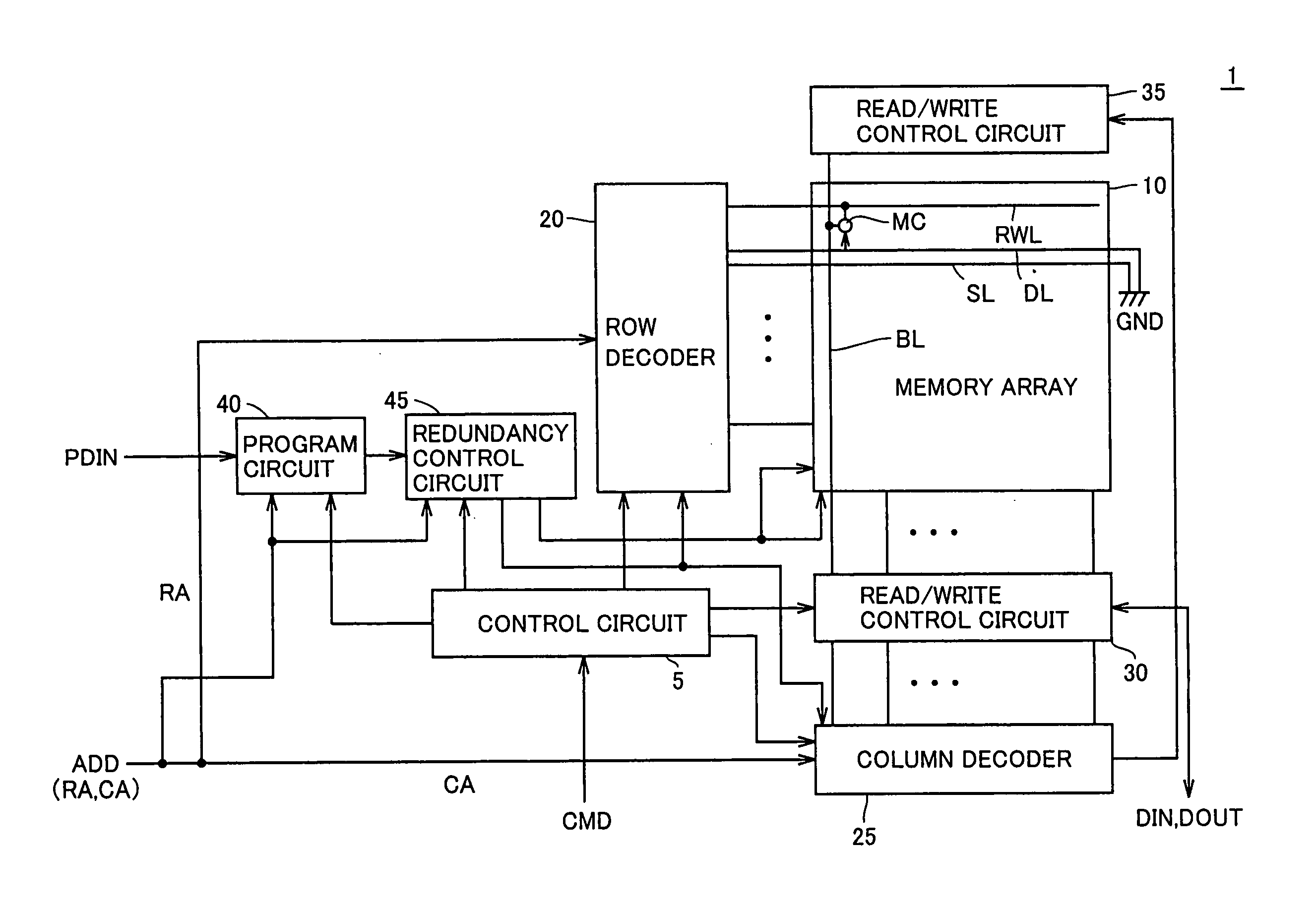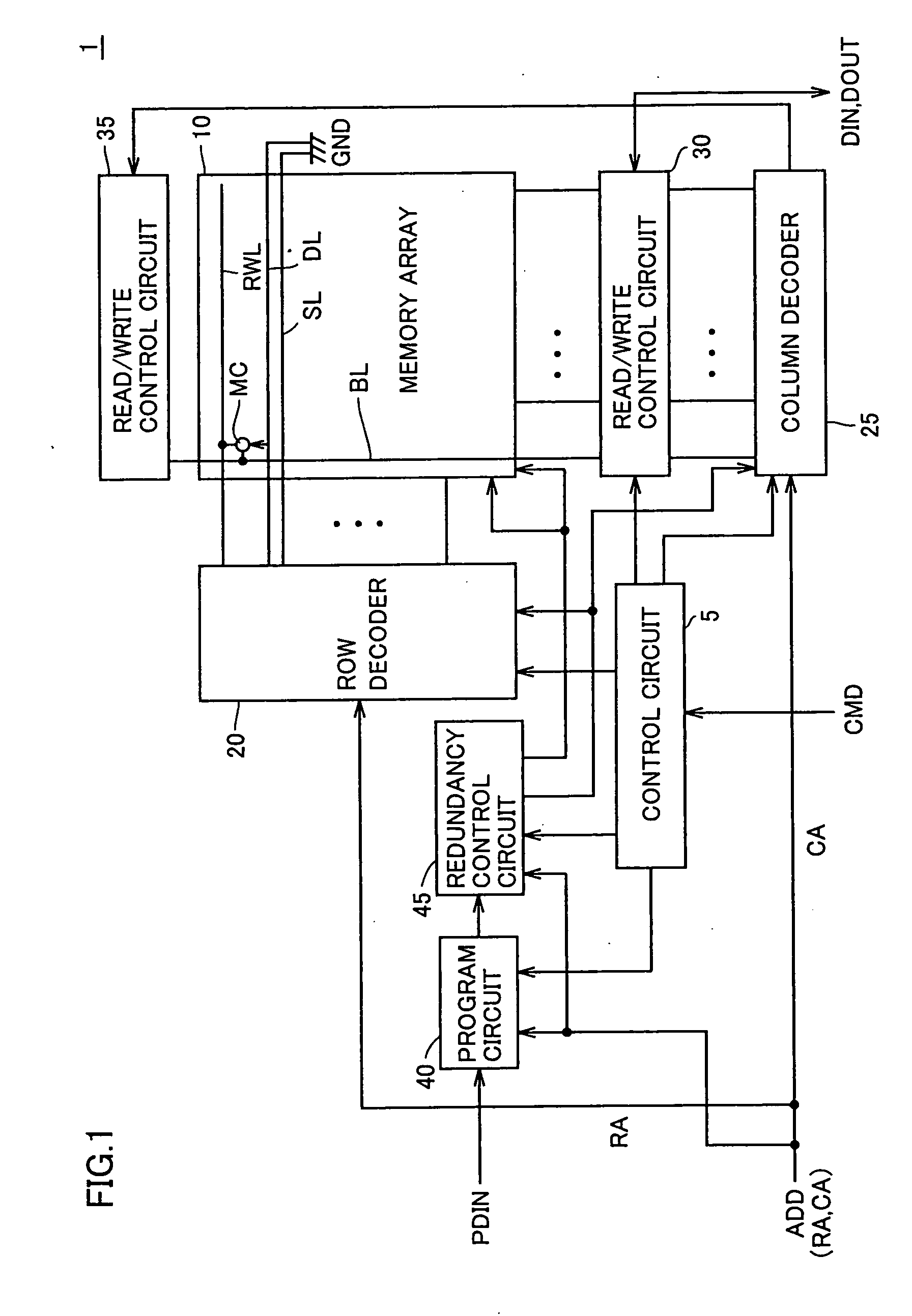Thin film magnetic memory device storing program information efficiently and stably
a program information and memory device technology, applied in the direction of digital storage, electric analogue stores, instruments, etc., can solve the problems of data once programmed being rewritten, affecting the efficiency of program information storage, and wasting time and cost in the programming process, so as to achieve efficient and stable storage of program information.
- Summary
- Abstract
- Description
- Claims
- Application Information
AI Technical Summary
Benefits of technology
Problems solved by technology
Method used
Image
Examples
first embodiment
[0050] First Embodiment
[0051] Referring to FIG. 1, the MRAM device 1 according to an embodiment of the present invention performs random access in accordance with a control signal CMD and an address signal ADD supplied externally, and performs input of write data DIN and output of read data DOUT.
[0052] MRAM device 1 is provided with a control circuit 5 for controlling the entire operation of MRAM device 1 in accordance with control signal CMD, and a memory array 10 having a plurality of MTJ memory cells arranged in rows and columns. Memory array 10 includes a plurality of normal MTJ memory cells arranged in rows and columns, each addressable by address signal ADD, and spare memory cells (not shown) for replacement of defective normal memory cells. In memory array 10, word lines, digit lines and source lines are arranged corresponding to respective memory cell rows, and bit lines are arranged corresponding to respective memory cell columns.
[0053] In FIG. 1, one memory cell MC is sh...
second embodiment
[0150] Second Embodiment
[0151] In the first embodiment above, the configuration of program circuit 40 having integrally arranged memory cells PMC capable of efficiently storing program data has been described.
[0152] In the second embodiment of the present invention, a program circuit configured with a program element automatically decoding program data upon power-up is described.
[0153] Referring to FIG. 16, a program unit PMU constituting the program element according to the second embodiment includes: a bit line SBL for supplying a data write current; bit line drivers WWRb, WWRa provided corresponding to one end and the other end of bit line SBL; a program cell unit PMCUb provided on the one end of bit line SBL and electrically coupled to bit line SBL and storing program data; a program cell unit PMCUa provided on the other end of bit line SBL and storing program data; and a write / read control unit 140 generating write control signals WDTa, WDTb and control signals DA, / DA in res...
third embodiment
[0212] Third Embodiment
[0213] In the third embodiment of the present invention, application of program unit PMU in the second embodiment to a system employing a field programmable gate array (FPGA) is explained. The FPGA is a semiconductor device which has an internal circuit provided therein in advance and which can be changed to perform a prescribed operation by externally providing data and others to the internal circuit afterward. Generally, the program information for use in such a change of the operation is stored in a prescribed region within the internal circuit.
[0214] Referring to FIG. 27, the FPGA according to the third embodiment includes a plurality of circuit blocks BK arranged in rows and columns, and interconnection regions are provided between these blocks. In the interconnection regions, a plurality of horizontal interconnection groups XG and a plurality of vertical interconnection groups YG are provided in a row direction and in a column direction, respectively.
[...
PUM
 Login to View More
Login to View More Abstract
Description
Claims
Application Information
 Login to View More
Login to View More - R&D
- Intellectual Property
- Life Sciences
- Materials
- Tech Scout
- Unparalleled Data Quality
- Higher Quality Content
- 60% Fewer Hallucinations
Browse by: Latest US Patents, China's latest patents, Technical Efficacy Thesaurus, Application Domain, Technology Topic, Popular Technical Reports.
© 2025 PatSnap. All rights reserved.Legal|Privacy policy|Modern Slavery Act Transparency Statement|Sitemap|About US| Contact US: help@patsnap.com



